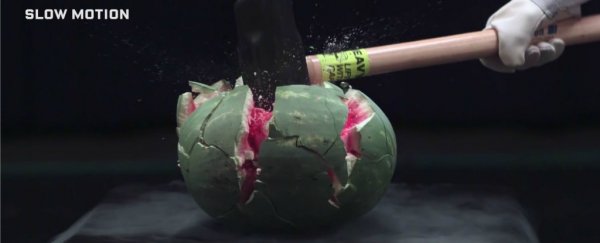If you've ever wondered what would happen if you took a watermelon, dipped it in liquid nitrogen until it reached a chilly -195 degrees Celsius (-320 degrees Fahrenheit), then smashed the living crap out of it with a sledge hammer, don't worry, Wired's Brent Rose is here to help.
In the latest instalment of his video series OOO, Rose demonstrates what happens to everyday objects when they're frozen to extremely low temperatures, and every bit is recorded in glorious slow-mo.
While smashing frozen things is a great way to spend an afternoon, there's some pretty cool science at work here, too.
Nitrogen is all around us all of the time. The air you're breathing right now is around 78 percent nitrogen. This nitrogen gas can be transformed into its liquid state when it is brought down to about -195 degrees Celsius (-320 degrees Fahrenheit). Above this temperature, liquid nitrogen will boil and turn right back into gas.
Because of these extremely low temperatures and the fact that it's pourable, liquid nitrogen is the perfect substance to freeze just about anything, but what actually happens to these objects as they freeze?
"The kinetic theory of matter can be used to explain how solids, liquids and gases are interchangeable as a result of increase or decrease in heat energy," University of Leicester researchers explain. "When an object is heated the motion of the particles increases as the particles become more energetic. If it is cooled, the motion of the particles decreases as they lose energy."
In other words, the particles inside an object slow down, and the tiny spaces between these particles shrink as something freezes. Most of the time, this causes the object to become very brittle and hard (think: a sheet of ice).
When things are frozen with liquid nitrogen, their particles slow tremendously, and the spaces between the particles almost vanish. When this happens, the objects can be shattered if a strong enough force (say, a sledge hammer) makes an impact, which is exactly what Rose set out to test in the video.
For the first 'experiment', Rose takes a lock and smacks it with a hammer at room temperature. Though the blow creates a sizeable dent in the side of the lock, it's still operational. After getting a dip in some liquid nitrogen, though, the particles inside the lock tighten together and basically stop moving, leaving no room for them to flex (or dent). Instead, it shatters.
While this works for many objects, there are a few that resist the deep freeze. When Rose dipped a baseball into the liquid nitrogen and smacked it with a bat, nothing happened at all.
This is because a baseball is made of cork wrapped in layers of cloth and covered with leather, making it a very good insulator because lots of air is trapped inside.
For the baseball to break, it would have had to be left in the liquid nitrogen long enough that the air temperature between all of those layers evened out. Otherwise, the air remains warm enough keep the ball intact.
Another surprising thing that doesn't freeze immediately when exposed to the liquid nitrogen was Rose himself. In a segment he dubbed 'the cold shoulder', Rose has one of his colleagues throw a cup of the nitrogen on his shirtless back, and it doesn't even leave a mark.
Rose was able to go about his day without any frost bite because of the Leidenfrost Effect, which states that when a liquid hits an object that's way hotter than itself, it immediately transforms into a gas, creating a barrier between Rose's back and the liquid nitrogen.
But this would have gone completely wrong if the nitrogen was able to pool anywhere on Rose, because then the gas barrier would have collapsed and the liquid would have sat on his skin, freezing it instantly.
Check out the video above to see Rose freeze and break a bunch of other stuff, too. Oh, and there's a sex toy involved, so consider it NSFW (at least a minute of it anyway), and remember: don't try any of this at home.
